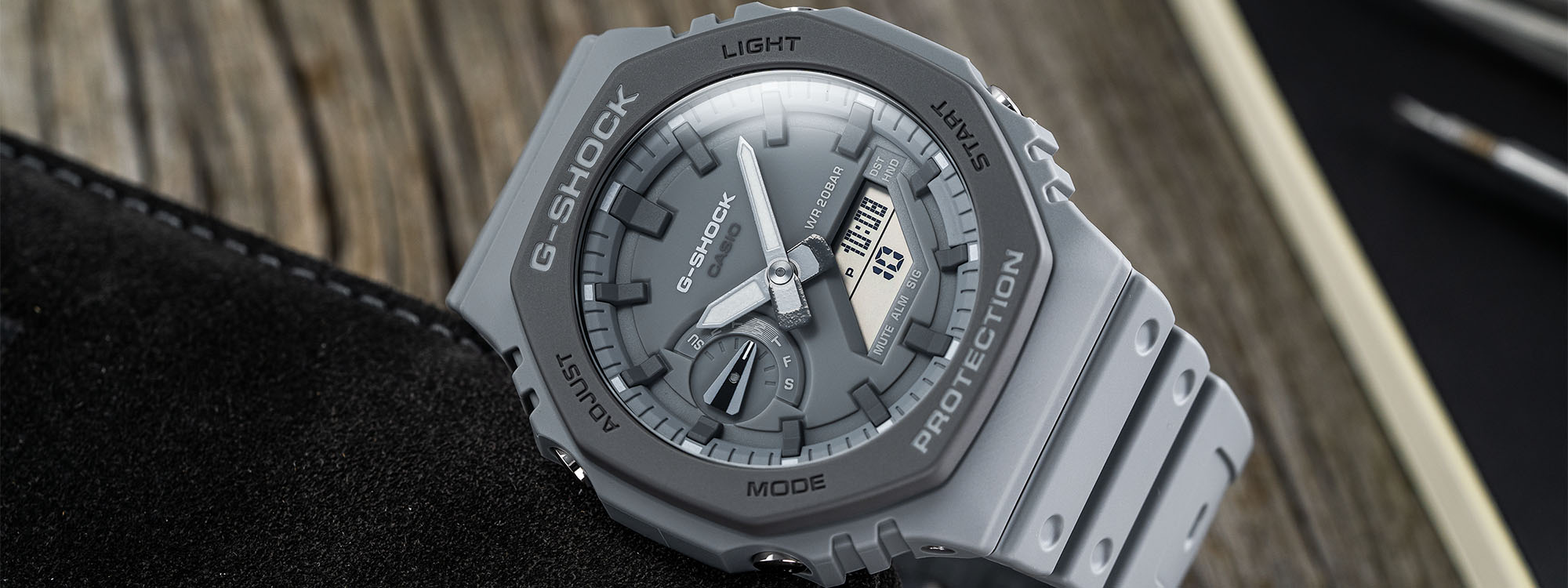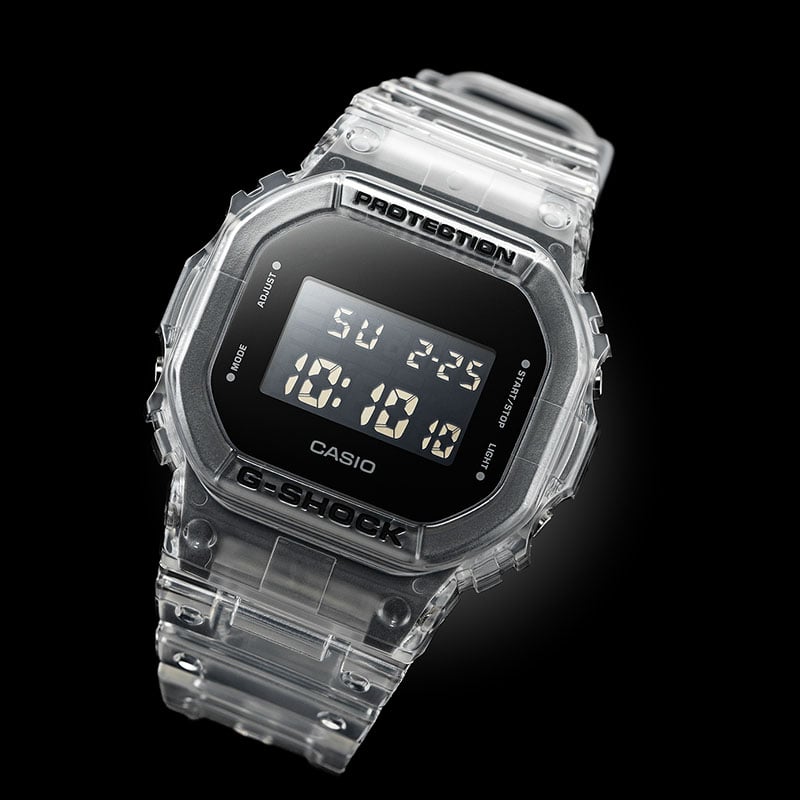Before getting into the CasiOak, let's revisit some brand history. Japan’s Casio, renowned as the producer of the world’s first portable electronic calculator, released its first watch, the quartz-powered Casiotron, in 1974. But it wasn’t until 1983 that the electronics giant really made an impact on the timepiece world with the introduction of the first G-Shock. Conceived by Casio engineer Kikuo Ibe, who had experienced the loss of the beloved pocket watch his father had given him after he accidentally dropped it on a hard floor, the G-Shock was positioned from the beginning to be the world’s toughest watch, and the first to use urethane rubber in its construction.

From the original DW5000-C (recent version pictured above), with its rectangular case, all-digital LCD timekeeping display, and quartz movement with 10-year battery life, sprang an extensive family of G-Shocks, which by the time of the model’s 40th anniversary in 2023 would include both digital and analog-digital models as well as a variety of high-tech case materials. In 2019, the G-Shock family tree added a branch that made fans of a certain type of high-end sport-luxury timepiece stand up and take notice — namely the so-called “CasiOak” models (below), whose roots, it could be argued, reach back not only farther than the first G-Shock but even farther than the Casiotron.

Why "CasiOak?"
It was a Swiss luxury watch, as groundbreaking in its own way as the G-Shock, that ultimately paved the way for the modern product family that we spotlight here. In 1972, two years before Casio threw its hat into the timepiece ring, venerable Swiss manufacture Audemars Piguet took a bold gamble on a model called the Royal Oak, its own first attempt at a fusion of sport watch and dress watch elements. The brainchild of visionary designer Gérald Genta, the Royal Oak was noteworthy for its radical-at-the-time signature feature, an octagonal-shaped bezel with visible screws, and for its smoothly tapering steel bracelet that integrated tightly to the case. (Click here for a deeper dive into the Audemars Piguet Royal Oak, below, and its impact on the watch industry.)

The watch’s design language, albeit not universally embraced by the market at first, would prove to be immensely influential: the same decade saw the debut of models like the Patek Philippe Nautilus (also designed by Genta), Girard-Perregaux Laureato, Tissot PRX, and Vacheron Constantin 222, the aesthetic forerunner of the modern Overseas collection. The popularity of this new style later exploded in the 1990s and into the 21st Century, and the 800-pound gorillas of the category — the Royal Oak and Nautilus — became victims of their own success, with supply perpetually unable to meet demand. Stepping into the breach to fill that demand have been brands like Bell & Ross, with its BR 05, Chopard with its Alpine Eagle, and Tissot, which resurrected the PRX (below) as an affordable alternative to the Royal Oak, the Nautilus, and their pricey brethren.

Even a Tissot PRX, however, will run you into the hundreds of dollars at a minimum, and more if you want one with a mechanical movement. And the Royal Oak “look” has so saturated the market — if you need further proof, check out this roundup of Royal Oak alternatives for various budgets — that even enthusiasts with the most modest of means are seeking out something they can afford that ticks as many of those aesthetic boxes as possible. Here is where Casio, specifically the G-Shock brand — and yes, as of several years ago, Casio does consider G-Shock its own brand rather than a model series — steps in with its decades-long winning formula of making watches with an eye toward stylishly populist design, up-to-date technology, and mass-market pricing.

CasiOak Roots: The G-Shock GA2100
The G-Shock GA2100 debuted in 2019 and swiftly garnered the nickname “CasiOak” for its eight-sided bezel that was, to many, immediately evocative of the one on Audemars Piguet’s flagship timepiece, which was famously inspired by a vintage scuba diver’s helmet. The reference was far from a note-by-note homage to the Royal Oak; in fact, the design team behind it claims that the primary inspiration was the bezel on the earliest G-Shock models — which was, upon close examination, technically an octagon, albeit a much more rectangularly oriented one. It lacks some emblematic elements, such as the bezel’s visible eight-sided screws positioned at the cardinal points, for example. (Some might also point out that the side-mounted “bumpers” on the model are actually more reminiscent of the Patek Philippe Nautilus than the Royal Oak, even though this element has also been a longtime G-Shock staple.) But its robustly sized resin case, integrating into the segmented, bracelet-like urethane strap, and its predominantly analog-display dial (with some digital elements tucked into windows in the lower right) proved enough to catch the eye of many a mechanical-watch purist.

At 45.4mm by 48.5mm in diameter, the resin case comes in at a somewhat surprisingly modest 11.9mm thick — surprising, because G-Shock models have long been famous for their chunkiness in addition to their array of built-in functions. The relative thinness of the “CasiOak” proved to be another factor that made it appealing to fans of luxury timepieces, who tend to lean toward a slimmer profile. All that said, the GA2100 watches have plenty of appealing elements for the core G-Shock enthusiast, arranging an information-rich display in an analog-digital hybrid format. Two thick baton hands reveal the time on wide hour appliqués mounted on a sculpted flange, while an additional hand points to the day of the week on an arc-shaped indicator at 9 o’clock. Between 3 and 6 o’clock, the small LCD screen displays info including chronograph readouts, additional time zones, alarms, countdown timers, and a full auto calendar. Button-activated LED lights illuminate the dial for easy nighttime legibility, and G-Shock’s hallmark Carbon Core Guard case structure renders the watch water-resistant to an impressive 200 meters. The GA2100 in all its various colorways and designs, is also a watch that just about any aficionado could afford, priced around $100.

Connected CasiOak: G-Shock GAB2100
With the GAB2100 version of the “CasiOak,” released in the following year, G-Shock made a statement that it wasn’t catering only to penny-pinching wannabe Royal Oak owners but to its core audience of enthusiasts, who cherish the G-Shock’s continuing evolution on the technological side. The “B” in the alphanumeric reference number here refers to “Bluetooth,” and these members of the CasiOak family boast an array of smartwatch-style functionalities that come with pairing the timepiece with a devoted Casio Watches app on the owner’s smartphone. The owner can dispense with the ritual of setting the watch and adjusting the time, as all this can be accomplished wirelessly through the app, and the built-in Tough Solar technology utilizes light to constantly recharge the movement’s battery. The 9 o’clock display on the Bluetooth-equipped CasiOaks features indicators for mode and battery life rather than a weekday display. The Bluetooth and Tough Solar logos appear on the dial at 3 o’clock; below them lie the same digital windows as on the GA2100 versions, with the same plethora of functions.

The list of features packed into the Bluetooth-enabled CasiOaks reads like a tech geek’s ultimate device wish list: a world-time function capable of displaying 38 time zones, plus UTC, or Universal Coordinated Time; calendar indications that will be accurate through the year 2099 without any need to reset for differing lengths of months or even leap years; a stopwatch that can track elapsed times, including lap times and split times, up to 24 hours and with an accuracy to 1/100-second; and a countdown timer that can be set for up to 60 minutes, to name some of the high-tech highlights. Also, like the non-Bluetooth models, the GAB2100s include a button-operated “hand-shift,” a useful feature whereby the owner can move the analog hands out of the way in order to read information on the digital display. Adding all the Bluetooth options, incidentally, only adds about $50 to the cost; GAB2100 CasiOaks start around $150.
 CasiOak Branches Out: Full Metal
CasiOak Branches Out: Full Metal
If there’s been a predominant storyline around the G-Shock in the past five years or so, it’s been the family’s gradual but aggressive push into higher price segments and more elevated levels of luxury and collectibility. The CasiOak watches are no exceptions, following up other “Full Metal” versions of previous G-Shock models that substitute metals like stainless steel, rather than the brand’s traditional resin, for the core case material. The GM2100 (“M” for “metal”) debuted in 2021, and the Bluetooth-enabled GMB2100 followed shortly thereafter; the former models come mounted on the familiar G-Shock resin strap, the latter on steel link bracelets with exposed screws.

Both are just a smidgen smaller in diameter than the resin-cased models — 44.4mm x 49.3mm for the GM2100s, with a thickness of 11.8mm; and 44.5mm x 49.9mm with a 13.2mm profile for the GMB2100s. Sans Bluetooth on a resin strap, the GM2100 models retail for $200, while the “smartest” and most luxuriously designed models — the metal bracelet-mounted GMB2100s, including the gold-toned GMB2100GD-5A pictured below, command the highest price in the extended CasiOak family, at $550-$600. Bottom line? One of these watches likely won't pay for your kid's college tuition if you choose to resell it, but it also won't require you to take out a second mortgage or languish on an interminable wait list to purchase one. And you'll probably want to wear it. A lot.

Trimmed-Down CasiOak: G-Shock GMAS2100/GMS2100
Casio wasn’t quite finished whittling away at the dimensions of its G-Shock “CasiOak” case, however, as watch-enthusiast tastes continue to drift toward more modest and arguably more unisex designs. The GMAS2100 series, launched in 2021, was the first CasiOak expressly aimed at women, though it certainly could find plenty of fans among smaller-wristed men as well.

The Carbon Core Guard-reinforced resin cases measure 42.9mm wide — relatively dainty for a G-Shock — with a 46.2mm lug-to-lug length and an 11.2mm thickness, the latter slimmed down by nearly a whole millimeter from the GA2100 models. The lineup of so-called “Mini CasiOaks” features an appealing array of mostly feminine-targeted colorways, from hot and pastel pinks (as above) to powder blues to peaches and whites, along with several bold bicolor executions.

Right on the heels of the GMAS family came the GMS models (above), which swap out the resin cases for “Metal Covered” versions with steel bezels for a sleeker look. Size-wise, these are also marketed as “Women’s” watches, with 40.4mm width, 11mm thickness, and 45.9mm length. The octagonal bezel itself is subtly slimmer than those of its predecessors and the dials, like those of the resin-cased models, boast a wide breadth of trendy pastel hues.

CasiOak's Newest Faces
Most recently, the CasiOak collection has expanded to include an all-analog model that might just be the iteration that speaks most directly to enthusiasts of the Royal Oak and other traditional luxury watches. The GMCB2100 is, in fact, the first analog chronograph model in G-Shock’s expanding Full Metal collection (the “C” presumably signifying “chronograph”), with a classical 6-9-12 tricompax dial and a metal bezel with a circular hairline finish on the surface and mirror polishing on the edges. The watches (above) are on the bigger side — 46.3mm by 51.3mm in diameter and 12.4mm thick — and come on integrated metal bracelets with dimples that recall both the original rubber G-shock strap and the bracelet of Cartier’s Santos, one of the forerunners of the Royal Oak style. The price of admission for this level of CasiOak is $800.

Does the release of a non-digital CasiOak, on the heels of the decidedly upscale and upmarket-leaning Full Metal versions, point to even more luxurious executions for the era’s trendiest G-Shock, and will fans of the still-affordable GA2100 be ultimately priced out? If I had to guess, I’d say yes to the first point, no to the second. Casio (which you can learn more about here) and its G-Shock brand have proven over and over that they know their audience, and if anything, more options on the entry-level are just as likely. Take, for example, the Summer 2022 release of the GA2100 “Iridescent Color” models (example above), with their gradient rainbow dials, achieved by a vapor deposition process and inspired by summer sunset colors. Priced from $120 - $130, just slightly above the core models, they are yet another sign that G-Shock “CasiOak” options will remain as wide and versatile as ever, whether we’re talking aesthetics, technology, price, or a combination of all.






















































0 Comments